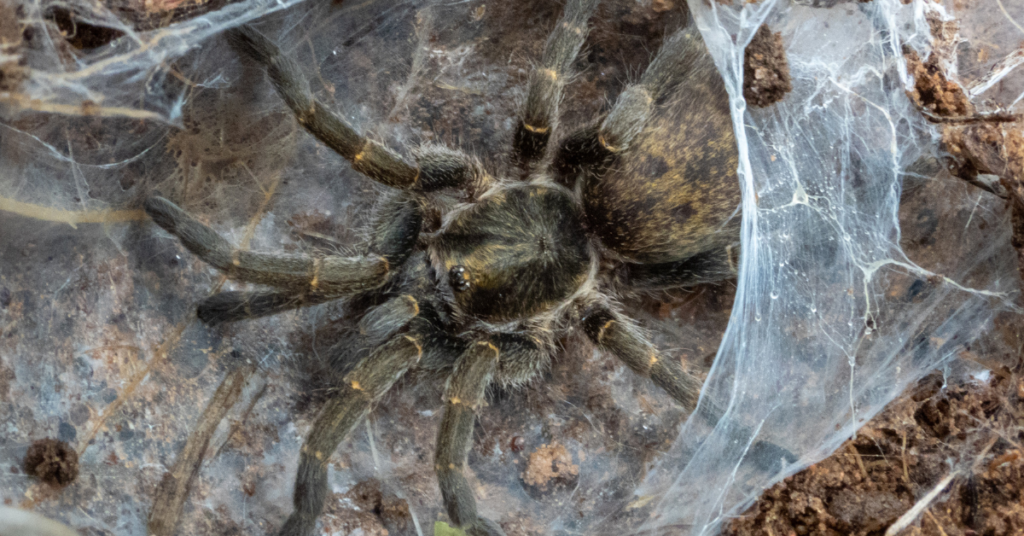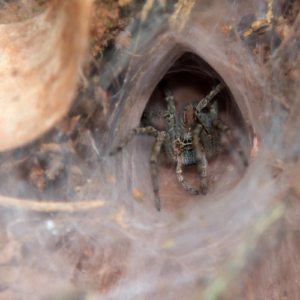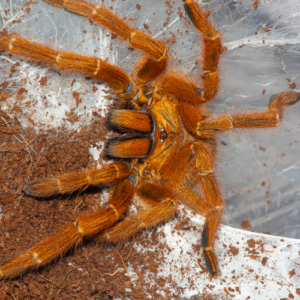
Tarantulas are just giant spiders so they must make webs, right? Wrong. Tarantula’s use silk for many things, but a web to catch prey isn’t one of them. Read on to find out more.
As you can see, tarantulas don’t build webs to catch their prey like other spiders. Let’s go into further detail.
 Structural Support
Structural Support
This is the one of the main reasons you will see a tarantula webbing up their enclosure. In the wild, tarantulas may be subjected to a wide array of different environmental conditions, so they must be sure that their creation is structurally sound.
It is most commonly seen within the tarantula’s burrow and around the opening of it. As tarantulas spend so much time in there, they’ll reinforce it with a layer of silk to add strength and durability.
Comfort
Whilst tarantulas have 8 legs, they still can find it difficult to get around their enclosure. A layer of silk coating different surfaces provides a great surface for them to climb and have a firmer grip on things.
In the wild, this has the added benefit of allowing for faster movement which comes in handy while hunting down prey.
Heavy Webbers
In captivity, you will notice certain species of tarantula do this to a further extent than others. There are many heavy webbing tarantulas, we’ve listed some of the below.
Green Bottle Blue, or GBB (Chromatopelma cyaneopubescens)

This gorgeous tarantula is a New World, semi-arboreal beast. Females live for roughly 14 years, and males roughly 4 years. Coming in at 6.25” (measured diagonally), it’s not a small tarantula.
Gabon Blue Dwarf Baboon Tarantula (Heterothele gabonensis)
The Dwarf Baboon tarantula is a further semi-arboreal that have shown communal tendencies. It is an Old World, that only grows up to 2-3”. Females live up to 7 years, while males only live up to 2 years.
Trinidad Olive Tarantula (Neoholothele incei)

This animal is another New World, and unlike most tarantulas, can be kept communally . Females live roughly 7 years whilst the males only live 2. It measures 2-3” when mature.
Orange Baboon Tarantula (Pterinochilus murinus)

The OBT is an Old World tarantula, which has the nickname of “orange bitey thing”. I think you can guess why! Females can grow up to 4-6” (measured diagonally), whilst males are slightly smaller at 3-4”.
Indian Violet Earth Tiger Tarantula (Chilobrachys fimbriatus)

These very rare tarantulas are Old World and extremely aggressive. They can grow up to 5.5” and are fast growing. Females live between 20-25 years whereas males live for 2-4.
Molting Mat
As mentioned in our article here on molting, tarantulas also create a silk like bed to lie on when molting.
Molting mats provide several purposes for tarantulas. First of all, they give them a nice soft area on which to undergo the uncomfortable molt process.
This is also extremely important as a freshly molted tarantula is a very sensitive one. Furthermore, this “molting mat” creates the benefit of alerting the vulnerable tarantula to any creatures that happen to wander near it during their molt.
Sperm Web
Another extremely useful job of tarantula silk, is for a sperm web. This is a special web created by a mature male in order to transfer sperm from the epiandrous fusillae to the palpal bulbs.
It is usually tubular in shape but that depends on species.
Watch this video of a male Brazilian White Knee (A. geniculate) doing exactly that. Amazing!
Hopefully you now know the importance and difference of a spider web versus a tarantula web. Interesting, isn’t it!
